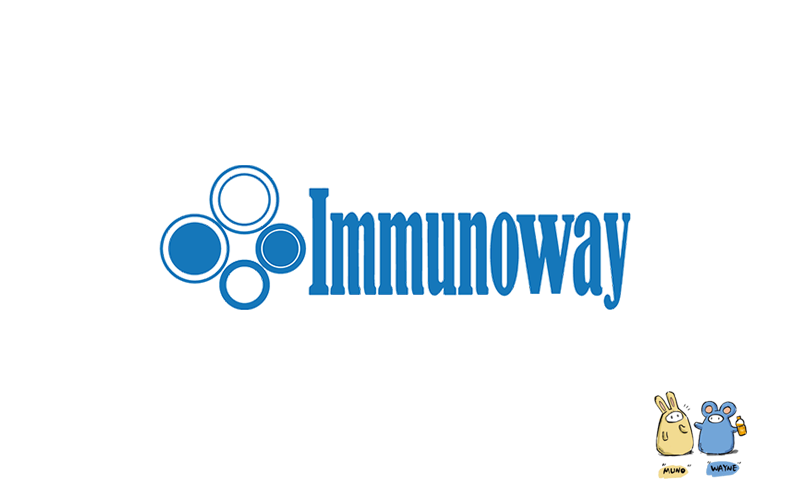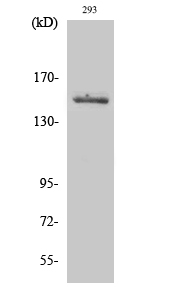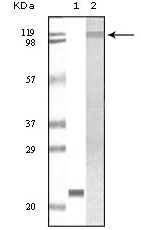
Catalog: YP1541
Size
Price
Status
Qty.
200μL
$600.00
In stock
0
100μL
$340.00
In stock
0
50μL
$190.00
In stock
0
Add to cart


Collected


Collect
Main Information
Target
Tyk 2 Phospho Tyr1054/1055
Host Species
Rabbit
Reactivity
Human, Mouse, Rat
Applications
WB
MW
134kD (Observed)
Conjugate/Modification
Phospho
Detailed Information
Recommended Dilution Ratio
WB 1:1000-2000
Formulation
Liquid in PBS containing 50% glycerol, 0.5% BSA and 0.02% sodium azide.
Specificity
This antibody detects endogenous levels of Tyk2 only when phosphorylated at Tyr1054 or tyr1055,and dually phosphorylated at two sites.The name of modified sites may be influenced by many factors, such as species (the modified site was not originally found in human samples) and the change of protein sequence (the previous protein sequence is incomplete, and the protein sequence may be prolonged with the development of protein sequencing technology). When naming, we will use the "numbers" in historical reference to keep the sites consistent with the reports. The antibody binds to the following modification sequence (lowercase letters are modification sites):HEyYR
Purification
The antibody was affinity-purified from rabbit serum by affinity-chromatography using specific immunogen.
Storage
-15°C to -25°C/1 year(Do not lower than -25°C)
Concentration
1 mg/ml
MW(Observed)
134kD
Modification
Phospho
Clonality
Polyclonal
Isotype
IgG
Related Products
Antigen&Target Information
Immunogen:
Synthesized phosho peptide around human Tyk2 (Tyr1054 and 1055)
show all
Specificity:
This antibody detects endogenous levels of Tyk2 only when phosphorylated at Tyr1054 or tyr1055,and dually phosphorylated at two sites.The name of modified sites may be influenced by many factors, such as species (the modified site was not originally found in human samples) and the change of protein sequence (the previous protein sequence is incomplete, and the protein sequence may be prolonged with the development of protein sequencing technology). When naming, we will use the "numbers" in historical reference to keep the sites consistent with the reports. The antibody binds to the following modification sequence (lowercase letters are modification sites):HEyYR
show all
Gene Name:
TYK2
show all
Protein Name:
Tyk 2 (Tyr1054/1055)
show all
Other Name:
TYK2 ;
Non-receptor tyrosine-protein kinase TYK2
Non-receptor tyrosine-protein kinase TYK2
show all
Background:
tyrosine kinase 2(TYK2) Homo sapiens This gene encodes a member of the tyrosine kinase and, more specifically, the Janus kinases (JAKs) protein families. This protein associates with the cytoplasmic domain of type I and type II cytokine receptors and promulgate cytokine signals by phosphorylating receptor subunits. It is also component of both the type I and type III interferon signaling pathways. As such, it may play a role in anti-viral immunity. A mutation in this gene has been associated with hyperimmunoglobulin E syndrome (HIES) - a primary immunodeficiency characterized by elevated serum immunoglobulin E. [provided by RefSeq, Jul 2008],
show all
Function:
Catalytic activity:ATP + a [protein]-L-tyrosine = ADP + a [protein]-L-tyrosine phosphate.,Disease:Defects in TYK2 are the cause of protein-tyrosine kinase 2 deficiency (TYK2 deficiency) [MIM:611521]; also called autosomal recessive hyper-IgE syndrome (HIES) with atypical mycobacteriosis. The syndrome consists of a primary immunodeficiency characterized by recurrent skin abscesses, pneumonia, and highly elevated serum IgE.,Domain:The FERM domain mediates interaction with JAKMIP1.,Function:Probably involved in intracellular signal transduction by being involved in the initiation of type I IFN signaling. Phosphorylates the interferon-alpha/beta receptor alpha chain.,online information:TYK2 mutation db,similarity:Belongs to the protein kinase superfamily. Tyr protein kinase family. JAK subfamily.,similarity:Contains 1 FERM domain.,similarity:Contains 1 protein kinase domain.,similarity:Contains 1 SH2 domain.,subunit:Interacts with JAKMIP1.,tissue specificity:Observed in all cell lines analyzed. Expressed in a variety of lymphoid and non-lymphoid cell lines.,
show all
Cellular Localization:
nucleus,cytoplasm,cytosol,cytoskeleton,membrane,extrinsic component of cytoplasmic side of plasma membrane,extracellular exosome,
show all
Tissue Expression:
Research Areas:
>>Necroptosis ;
>>Osteoclast differentiation ;
>>NOD-like receptor signaling pathway ;
>>JAK-STAT signaling pathway ;
>>Th1 and Th2 cell differentiation ;
>>Th17 cell differentiation ;
>>Toxoplasmosis ;
>>Hepatitis C ;
>>Hepatitis B ;
>>Measles ;
>>Influenza A ;
>>Human papillomavirus infection ;
>>Kaposi sarcoma-associated herpesvirus infection ;
>>Herpes simplex virus 1 infection ;
>>Epstein-Barr virus infection ;
>>Coronavirus disease - COVID-19
>>Osteoclast differentiation ;
>>NOD-like receptor signaling pathway ;
>>JAK-STAT signaling pathway ;
>>Th1 and Th2 cell differentiation ;
>>Th17 cell differentiation ;
>>Toxoplasmosis ;
>>Hepatitis C ;
>>Hepatitis B ;
>>Measles ;
>>Influenza A ;
>>Human papillomavirus infection ;
>>Kaposi sarcoma-associated herpesvirus infection ;
>>Herpes simplex virus 1 infection ;
>>Epstein-Barr virus infection ;
>>Coronavirus disease - COVID-19
show all
Signaling Pathway
Cellular Processes >> Cell growth and death >> Necroptosis
Organismal Systems >> Immune system >> Toll-like receptor signaling pathway
Organismal Systems >> Immune system >> NOD-like receptor signaling pathway
Organismal Systems >> Immune system >> Th1 and Th2 cell differentiation
Organismal Systems >> Immune system >> Th17 cell differentiation
Organismal Systems >> Development and regeneration >> Osteoclast differentiation
Environmental Information Processing >> Signal transduction >> JAK-STAT signaling pathway
Reference Citation({{totalcount}})
Catalog: YP1541
Size
Price
Status
Qty.
200μL
$600.00
In stock
0
100μL
$340.00
In stock
0
50μL
$190.00
In stock
0
Add to cart


Collected


Collect
Recently Viewed Products
Clear allPRODUCTS
CUSTOMIZED
ABOUT US
Toggle night Mode
{{pinfoXq.title || ''}}
Catalog: {{pinfoXq.catalog || ''}}
Filter:
All
{{item.name}}
{{pinfo.title}}
-{{pinfo.catalog}}
Main Information
Target
{{pinfo.target}}
Reactivity
{{pinfo.react}}
Applications
{{pinfo.applicat}}
Conjugate/Modification
{{pinfo.coupling}}/{{pinfo.modific}}
MW (kDa)
{{pinfo.mwcalc}}
Host Species
{{pinfo.hostspec}}
Isotype
{{pinfo.isotype}}
Product {{index}}/{{pcount}}
Prev
Next
{{pvTitle}}
Scroll wheel zooms the picture
{{pvDescr}}





















